Entity Framework is an Object Relational Mapper (ORM) from Microsoft that lets the application's developers work with relational data as business models. It eliminates the need for most of the plumbing code that developers write (while using ADO.NET) for data access. Entity Framework provides a comprehensive, model-based system that makes the creation of a data access layer very easy for the developers by freeing them from writing similar data access code for all the domain models. The initial release of Entity Framework was Entity Framework 3.5. It was released with .NET Framework 3.5 SP1 and Visual Studio 2008 SP1. Entity Framework has evolved a lot since then, and the current version is 6.0.
Entity Framework eases the task of creating a data access layer by enabling the access of data, by representing the data as a conceptual model, that is, a set of entities and relationships. The application can perform the basic CRUD (create, read, update, and delete) operations and easily manage one-to-one, one-to-many, and many-to-many relationships between the entities.
Here are a few benefits of using Entity Framework:
The development time is reduced since the developers don't have to write all the ADO.NET plumbing code needed for data access
We can have all the data access logic written in a higher-level language such as C# rather than writing SQL queries and stored procedures
Since the database tables cannot have advanced relationships (inheritance) as the domain entities can, the business model, that is, the conceptual model can be used to suit the application domain using relationships among the entities.
The underlying data store can be replaced relatively easily if we use an ORM since all the data access logic is present in our application instead of the data layer. If an ORM is not being used, it would be comparatively difficult to do so.
Let's try to visualize the Entity Framework architecture:

The Entity Framework architecture
From the preceding diagram, we can see that Entity Framework is written on top of the ADO.NET framework, and underneath, it is still using the ADO.NET methods and classes to perform the data operations.
Entity Framework relies on the conceptual data model for all its working. Let's try to understand what the Entity Data Model (EDM) is and how Entity Framework uses it to manage the database operations.
The conceptual data model is the heart of Entity Framework. To use Entity Framework, we have to create the conceptual data model, that is, the EDM. The EDM defines our conceptual model classes, the relationships between those classes, and the mapping of those models to the database schema.
Once our EDM is created, we can perform all the CRUD operations (create, retrieve, update, and delete) on our conceptual model, and Entity Framework will translate all these object queries to database queries (SQL). Once these queries are executed, the results will again be converted to conceptual model object instances by Entity Framework. Entity Framework will use the mapping information stored in the EDM to perform this translation of object queries to SQL queries, and the relational data to conceptual models.
Once our EDM is ready, we can perform the CRUD operations using the model objects. To be able to perform the CRUD operations, we have to use the ObjectContext class. Let's try to understand what the ObjectContext class is and how it can be used to perform the CRUD operations.
Once I have my EDM created, I will have all the entities that I can use in my application. However, I still need a central arbitrator that will let me perform various operations on these entities. This arbitrator in Entity Framework is the ObjectContext class.
The ObjectContext class is the main object in Entity Framework. It is the class that is responsible for:
Managing database connection
Providing support to perform CRUD operations
Keeping track of changes in the models so that the models can be updated in the database
The ObjectContext class can be thought of as an orchestrator that will manage all the entities in the EDM, and lets us perform all of the database operations for these entities.
Note
There is another class, DbContext, that is very similar to the ObjectContext class. In fact, the DbContext class is just a wrapper on top of the ObjectContext class. It is a rather newer API, and it provides a better API to manage database connections and perform CRUD operations.
Since DbContext is a better API, we will be using DbContext to perform all the database operations.
The ObjectContext class has a SaveChanges method that we have to call when we want to save the new or changed objects to the database.
Before we start looking at the various options to create the EDM, let's talk about the development styles followed by the developers. Some organizations have separate teams working on the application and the database. In such cases, the database design is done first and then the application development starts. Another reason for doing the database design first is when the application being developed is a data centric application itself.
Instead, it might be possible that the application demands the creation of the conceptual domain models first. Then, based on these conceptual domain models, the database tables will be created, and the application will implement the business logic in terms of these conceptual business models.
Another possibility is that we are creating an application that is highly domain-centric, and the application contains the domain models implemented as classes. The database is needed only to persist these models with all the relations.
There are a range of different scenarios you might find yourself in—different approaches become appropriate according to the demands of your situation.
Entity Framework provides support for all these development styles and scenarios. We know that Entity Framework operates on the EDM, and lets us create this EDM in three ways in order to cater to the different development styles:
Database First: This is the approach that will be used with an existing database schema. In this approach, the EDM will be created from the database schema. This approach is best suited for applications that use an already existing database.
Code First: This is the approach where all the domain models are written in the form of classes. These classes will constitute our EDM. The database schema will be created from these models. This approach is best suited for applications that are highly domain-centric and will have the domain model classes created first. The database here is needed only as a persistence mechanism for these domain models.
Model First: This approach is very similar to the Code First approach, but in this case, we use a visual EDM designer to design our models. The database schema and the classes will be generated by this conceptual model. The model will give us the SQL statements needed to create the database, and we can use it to create our database and connect up with our application. For all practical purposes, it's the same as the Code First approach, but in this approach, we have the visual EDM designer available.
Before we start looking at these development styles in detail, let's try to do a comparative analysis of these styles. It will help us in understanding these styles in detail.
In a Database First approach, the main benefit that the developers have is that if the database is created, they will spend very little time writing the data access layer. The EDM can be created from the database and then we can change it as per our application needs; our data access layer is ready to use. Here are a few scenarios where the Database First approach is very useful:
When we are working with a legacy database.
When we are working in a scenario where the database design is being done by another team of DBAs, and once the database is ready, the application development starts.
When we are working on a data centric application, that is, the application domain model is the database itself, and it is being changed frequently to cater to new requirements. For instance, when the tables are being updated regularly and new columns are being added to it frequently then we can simply use this approach, and the application code will not break. We simply have to write the code to cater to the newly added columns.
Similar to the Database First approach, in the Model First approach, we ultimately end up with the EDM. Using this EDM, we can create our conceptual model and the database. The only reason to choose the Model First approach is that we really want to use the Visual Entity Designer. There is no other strong reason to choose this approach over the other two.
The Code First approach is usually helpful where all the business logic is implemented in terms of classes, and the database is simply being used as a persistence mechanism for these models. Here are a few reasons why one might want to choose the Code First approach:
The database is simply a persistence mechanism for the models, that is, no logic is in the database.
Full control over the code, that is, there is no auto-generated model and context code.
The database will not be changed manually. The model classes will always change and based on this, the database should change itself.
This approach has been available since the first version of Entity Framework. In this approach, we start with an already existing database and start creating our EDM from the existing database. Let's try to see how this works using the Entity Framework Database First approach with our ToDo sample. To use the Entity Framework Database First approach, we have to add a new ADO.NET EDM to our project:
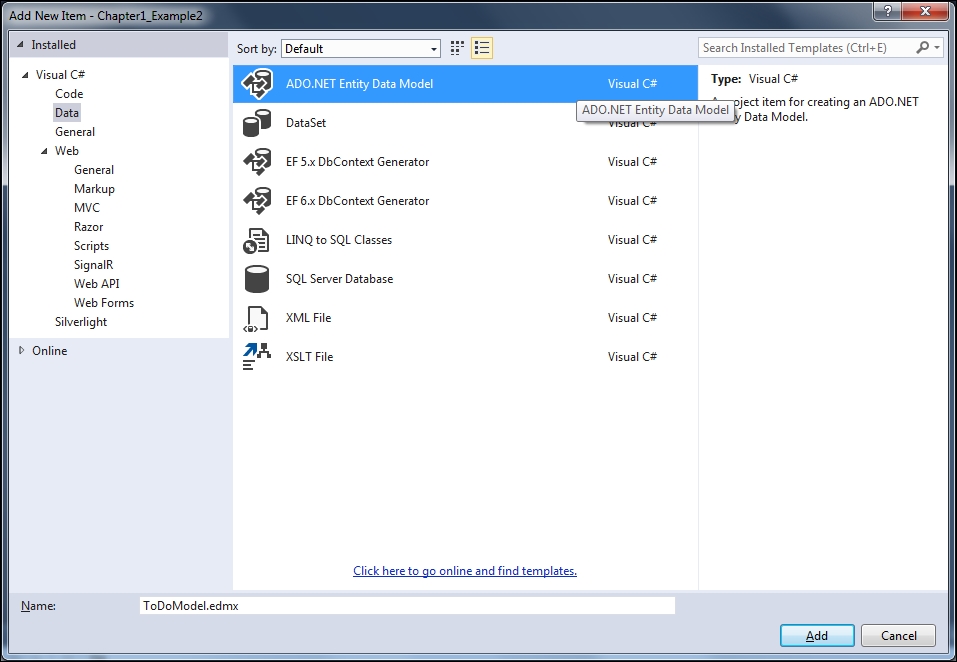
Add a new ADO.NET EDM
Let's start by defining a database for the ToDo application. Let's create a simple table that will keep a track of all the ToDo items:

A table schema for the sample ToDo application
The application requirements state that it should be possible to perform the following activities on the ToDos:
Read the list of ToDos
Create a ToDo item
Read a specific ToDo item
Update the status of a ToDo item
Delete a ToDo item
When we add the EDM, it asks us whether we want to create the conceptual model from the existing database, or if we want to create an empty model. For the Database First approach, we need to select an existing database. The following screenshot shows the wizard step that asks you to select the database:
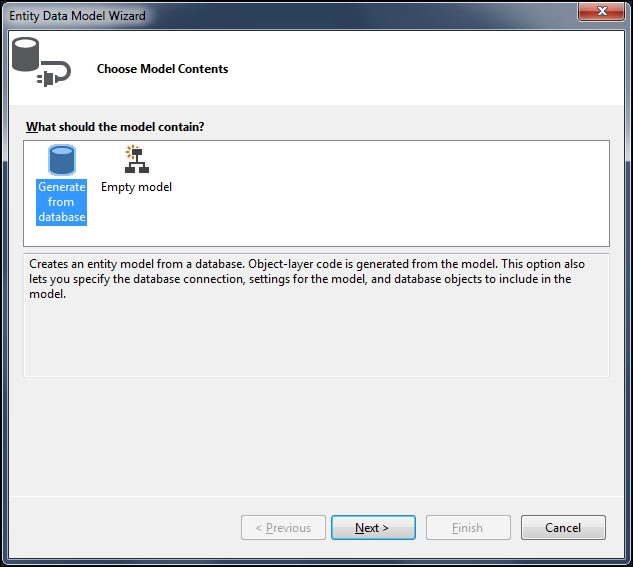
ADO.NET EDM wizard step 1—generate from the database
Once we choose to add the EDM, we need to specify the database that should be used to create it. So, the next step in the wizard will ask you for the connection to the database. Let's see what this wizard step looks like:
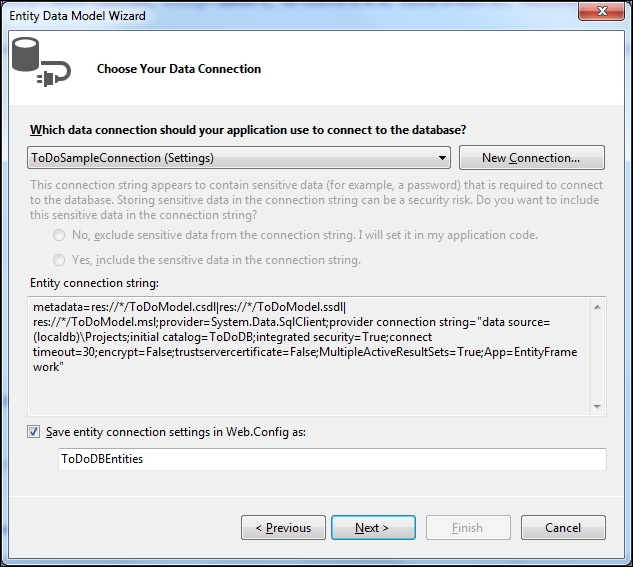
ADO.NET EDM wizard step 2—select the database
Once the connection is successfully established, the wizard shows us all the tables, views, procedures, and functions that we will want to access from our application. Using this wizard, we can also choose to include the foreign key relations in our conceptual model and singularization of the model name, in case the table name is plural in our conceptual model:
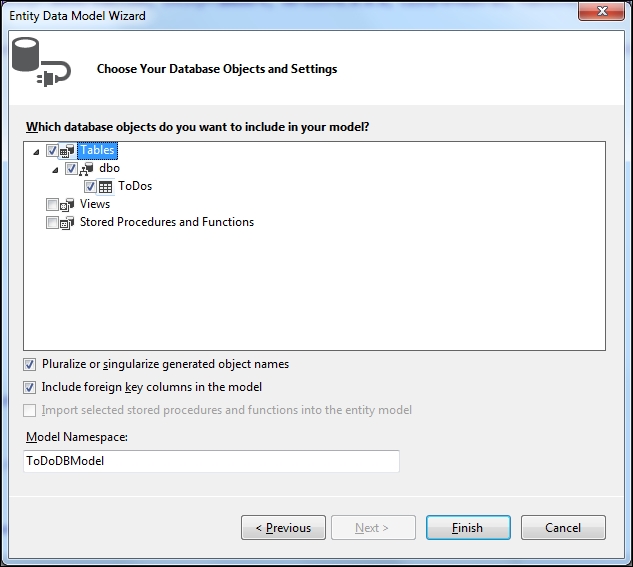
ADO.NET EDM wizard step 3—select the schema elements to be included in the EDM
Once the conceptual model is created, the EDM will be created for use in our application. The application will create a .EDMX file that contains all the information about our conceptual entity model and its mapping to the database tables:
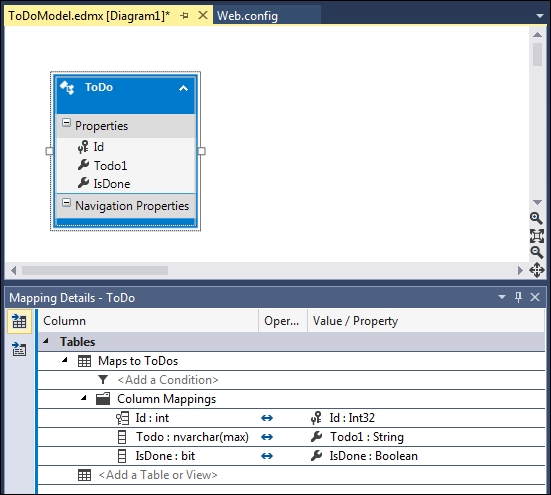
Visual Entity Designer showing the default model
We can modify the conceptual model and change the mapping using entity designer. Let's try to change the property ToDo1
to ToDoItem
in our conceptual model. Note that only the class property has been changed, and not the column name:
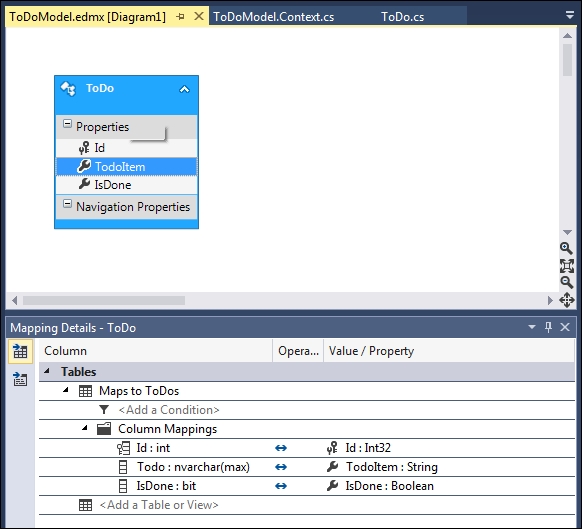
Visual Entity Designer showing the customized model
If we open the EDMX file, we can find the following three sections:
Conceptual schema definition: This specifies how a strongly typed model for our conceptual model will be created:
<edmx:ConceptualModels> <Schema Namespace="ToDoDBModel" Alias="Self" annotation:UseStrongSpatialTypes="false" xmlns:annotation="http://schemas.microsoft.com/ado/2009/02/edm/annotation" xmlns="http://schemas.microsoft.com/ado/2009/11/edm"> <EntityType Name="ToDo"> <Key> <PropertyRef Name="Id" /> </Key> <Property Name="Id" Type="Int32" Nullable="false" /> <Property Name="TodoItem" Type="String" MaxLength="Max" FixedLength="false" Unicode="true" Nullable="false" /> <Property Name="IsDone" Type="Boolean" Nullable="false" /> </EntityType> <EntityContainer Name="ToDoDBEntities" annotation:LazyLoadingEnabled="true"> <EntitySet Name="ToDos" EntityType="Self.ToDo" /> </EntityContainer> </Schema> </edmx:ConceptualModels>Storage schema definition: This specifies how the storage model is created, that is, how the values are stored in the database:
<edmx:StorageModels> <Schema Namespace="ToDoDBModel.Store" Provider="System.Data.SqlClient" ProviderManifestToken="2012" Alias="Self" xmlns:store="http://schemas.microsoft.com/ado/2007/12/edm/EntityStoreSchemaGenerator" xmlns="http://schemas.microsoft.com/ado/2009/11/edm/ssdl"> <EntityType Name="ToDos"> <Key> <PropertyRef Name="Id" /> </Key> <Property Name="Id" Type="int" Nullable="false" /> <Property Name="Todo" Type="nvarchar(max)" Nullable="false" /> <Property Name="IsDone" Type="bit" Nullable="false" /> </EntityType> <EntityContainer Name="ToDoDBModelStoreContainer"> <EntitySet Name="ToDos" EntityType="Self.ToDos" Schema="dbo" store:Type="Tables" /> </EntityContainer> </Schema> </edmx:StorageModels>Mapping: This specifies the mapping between the conceptual model and the storage model:
<edmx:Mappings> <Mapping Space="C-S" xmlns="http://schemas.microsoft.com/ado/2009/11/mapping/cs"> <EntityContainerMapping StorageEntityContainer="ToDoDBModelStoreContainer" CdmEntityContainer="ToDoDBEntities"> <EntitySetMapping Name="ToDos"> <EntityTypeMapping TypeName="ToDoDBModel.ToDo"> <MappingFragment StoreEntitySet="ToDos"> <ScalarProperty Name="Id" ColumnName="Id" /> <ScalarProperty Name="TodoItem" ColumnName="Todo" /> <ScalarProperty Name="IsDone" ColumnName="IsDone" /> </MappingFragment> </EntityTypeMapping> </EntitySetMapping> </EntityContainerMapping> </Mapping> </edmx:Mappings>
Tip
We should always prefer to change these values from the Visual Entity Designer. We can modify this XML manually to change it as per our needs, but Visual Entity Designer allows us to perform most of the modifications, and unless we need to make a change that is not supported by entity designer, we should try not to make them manually.
Once the EDM is created, we will get a class generated for each model object present in our conceptual model. We will also get the DBContext class that will let's use these strongly typed models:
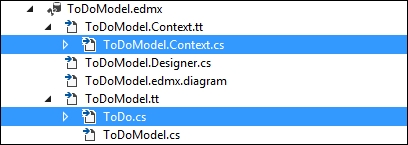
Solution Explorer showing the generated DbContext and Model class
The generated DBContext class will look like this:
public partial class ToDoDBEntities : DbContext
{
public ToDoDBEntities()
: base("name=ToDoDBEntities")
{
}
public virtual DbSet<ToDo> ToDos { get; set; }
}The generated model class will look like this:
public partial class ToDo
{
public int Id { get; set; }
public string TodoItem { get; set; }
public bool IsDone { get; set; }
}Now we are ready to write typed queries against the generated conceptual model, and Entity Framework will execute our queries on the database, and return the results in the form of these strongly typed models. Creating new data or updating the existing data is also very easy, because Entity Framework automatically tracks the changes we make in our models, and lets us save the changes to the database. This can simply be done by calling the SaveChanges method on the DBContext class. One important thing to note here is that the read operation can utilize Language-Integrated
Query (LINQ) to query the object data model, and Entity Framework will take care of converting it to the appropriate SQL query and retrieve the results.
If our application is a data-centric application, and all we need is to be able to perform CRUD operations using strongly typed objects, this is all that we are going to need. However, one of the great benefits of Entity Framework is being able to modify the conceptual models to better adapt to our domain needs, and then use the mappings to map the domain model to the database tables. We can have relationships between our domain models and still let them persist the data in a given set of tables.
Tip
In the Database First approach, the Entity Model is able to incrementally update the conceptual model if the database schema is updated. We just need to right-click on the visual designer and chose Update Model from Database.
In the later chapters, we will see how to manage multiple models, how we can define relationships between the entities, introduce inheritance hierarchies, customize entities, and much more. This will give you a good foundation to get started with the Entity Framework Database First approach if you haven't used it before, and will refresh your memory if you have.
The Model First approach is useful when we don't have a database to start with. Using this approach, we can create our models directly in the Visual Entity Designer, and then create the database schema based on our model. In this approach too, we can create entities and their properties, define relationships and constraints between the entities, and create inheritance relationships.
In this approach, we will first create the conceptual model, and based on this the database and the strongly typed objects will be created. To start with the Model First approach, we first need to add an ADO.NET EDM.
Let's try to add an ADO.NET EDM in our application:

Add a new ADO.NET EDM
Since we are planning to start with an empty model, we have to select an empty model in the wizard. The following screenshot shows the wizard step that asks you to select the option. We have to select Empty model in this step:

ADO.NET EDM wizard step 1—select the Model First approach
Once we choose the empty model, Entity Framework will show us the Visual Entity Designer. Now we can add the entities and relations to the designer area from the toolbar. The Entity Designer and the toolbar will look something like this:

An empty Visual Entity Designer after selecting the Model First approach
Let's try to add a new entity to our ToDo application and add properties to that model. Let's add a few properties to our ToDo model:

Adding a new property from Visual Entity Designer
Let's add the scalar properties needed for our ToDo model. Let's make the ID field a primary key field, a string property for ToDoItem, and a Boolean property for IsDone:

Visual Studio's Property panes showing the properties of a conceptual model
The created entity will look something like this:

The final model created from the Visual Entity Designer
Once we have the conceptual model created for our application, we have to create the database from this conceptual model. This can be done by right-clicking on the entity and choosing Generate Database from Model:

Generating database scripts from the Visual Entity Designer
This will prompt you to select the database connection. This wizard will not create the actual database, but it will generate the DDL for us, and we will have to use that DDL to create the database ourselves:

Wizard step to select the connection string to be used for a generated database script
After we select the database connection, the wizard will give us the SQL to create the database on the specified connection:

Wizard step showing the create database script
We can now copy this SQL and create the database. The Entity Framework has already created connectionString to use this connection, and wired up the DBContext class to perform the operations on this database. Let's take a look at the generated DbContext class:
public partial class ToDoModelContainer : DbContext
{
public ToDoModelContainer()
: base("name=ToDoModelContainer")
{
}
public virtual DbSet<ToDo> ToDoes { get; set; }
}The strongly typed objects will also be generated from the conceptual model. Let's take a look at our generated ToDo class:
public partial class ToDo
{
public ToDo()
{
this.IsDone = false;
}
public int Id { get; set; }
public string ToDoItem { get; set; }
public bool IsDone { get; set; }
}If we are using the Model First approach, one important thing to consider is that the incremental changes in our model will not perform the incremental updates to the database. Rather, it will give us the SQL to create the updated database from the ground up.
Tip
If we want to perform incremental updates to the database, we can use the Database Generation Power Pack from Microsoft (https://visualstudiogallery.msdn.microsoft.com/df3541c3-d833-4b65-b942-989e7ec74c87/). Using this, we can perform incremental updates to the database.
Now, let's take a look at the Entity Framework Code First approach. In this approach, we will start by creating the model classes ourselves. We will then implement our business logic against these classes, and then if we need to persist these models, we can use the Entity Framework Code First framework to save these models to the database. Thus, the Entity Framework Code First approach enables us to write simple C# classes, that is, Plain Old CLR Objects (POCOs) for our models, and then lets us persist them in a data store by defining a DbContext class for our model classes.
So, if we want to implement our ToDo application using the Code First approach, we will first have to create the ToDo model ourselves. Let's create a simple ToDo class that will keep track of our ToDo items:
public class ToDo
{
public int Id { get; set; }
public string ToDoItem { get; set; }
public bool IsDone { get; set; }
}Once we have the ToDo class ready, we need to start thinking about how the database will be created from our classes. We need to tell Entity Framework how to use our classes and generate the database accordingly. We want to tell the database generation module about all the persistence information, such as table names, key columns, and so on. We can do this in our model classes. So, if we try to put these attributes in our model class, our resultant ToDo model will look like this:
[Table("ToDo")] // Table name
public class ToDo
{
[Key] // Primary key
public int Id { get; set; }
[Column("ToDoItem", TypeName="ntext")]
public string ToDoItem { get; set; }
[Column("IsDone", TypeName="bit")]
public bool IsDone { get; set; }
}In the preceding code, we updated our class with a table attribute passing in the table name. This will tell the Entity Framework that a table should be created for this class. Each property of the class can be updated with the Column attribute, and we can specify the name of the column this property should be mapped to and the data type. The Key attribute will be used to specify the property that should be used as a primary key.
Entity Framework uses the DBContext class to save the models to the database. In the Code First approach, we need to create the DBContext class ourselves too. Let's see how we can implement our DBContext class:
public partial class ToDoDBContext : DbContext
{
public ToDoDBContext()
: base("name=ToDoConnectionString")
{
}
public DbSet<ToDo> ToDoes { get; set; }
}The context class that we are creating should be derived from the DbContext class. The context class will also keep DbSet of ToDos that will represent the list of ToDo items being retrieved from the table. The constructor of the context class will pass the name of connectionString to the base DbContext class. This connectionString will be used to connect to the database.
Another possibility is to keep the name of the connectionString the same as the DbContext class name. The Entity Framework will be able to use the corresponding DbContext class with this connectionString to persist the data. This is an example of the Convention over configurations principle. However, this is also flexible, so that we have the possibility of giving custom names to the connectionStrings.
Now to be able to use Entity Framework to persist the data, we just need to create this connectionString in the XML configuration, and Entity Framework will take care of creating the database and performing the CRUD operations on their respective models.
This has shown you how to use the Code First approach using a single model. In later chapters, you will see how to use multiple models and have relationships between them, how we can define complex types, and customize models as per our application requirements.
We have looked at how Entity Framework supports various development approaches and lets us create the conceptual model and data access logic very easily. We have seen that Entity Framework depends on the EDM to perform the database CRUD operations, and we have also looked at the various ways to create the conceptual model and map it to the database using the Database First, Model First, and Code First approaches.
To fully understand the benefits of Entity Framework over ADO.NET, we must also look at how easy and efficient it is to use Entity Framework to perform the actual operations. This will also show how performing CRUD operations is the same, irrespective of the approach we take. Let's now see how we can perform CRUD operations using Entity Framework to fully understand the benefits of Entity Framework.
We will perform CRUD operations on our ToDo model using the Entity Framework DbContext class.
Tip
It doesn't matter which approach we select to create the database and conceptual model (Database First, Code First, or Model First); from the code perspective, it's the same code that the developers need to write in order to use Entity Framework.
Now let's say we have a model for our ToDo item, that is, ToDo. We also have the DbContext class created to perform CRUD operations on the ToDo model. Let's take a look at how we can use Entity Framework to perform CRUD operations on our ToDo model. The important thing to note in these examples would be the use of LINQ. We will write all our queries in LINQ, and Entity Framework will take care of converting it to the appropriate SQL and return the results.
The way Entity Framework works is that using the DbContext class, we can retrieve all the data by simply accessing the model collection associated with the view. So, to fetch a list of items, we just need to get the model collection from the context class:
using(ToDoDBEntities db = new ToDoDBEntities())
{
IEnumerable<ToDo> todoItems = db.ToDos;
}Let's try to understand the preceding code:
We created an object of the
DbContextclass:ToDoDBEntities db = new ToDoDBEntities();
We then used the
DbContextobject to fetch theToDoentities:IEnumerable<ToDo> todoItems = db.ToDos;
After this call, the list of ToDo items will be available in the ToDo items collection if we enumerate ToDo items. Entity Framework will internally perform the following activities for us to fetch the result:
Parsed our request for the data.
Generated the needed SQL query to perform this action.
Used the context class to wire up the SQL to the database.
Fetched the results from the database.
Created the strongly typed models from the retrieved results and return them to the user.
If we want to retrieve a single item from the model collection, we have many ways of doing it. Typically, we can use any LINQ function to fetch the single record from the model collection. Also, if we want to fetch the result using the primary key, we can use the Find method to do it. Let's look at a few ways in which we can retrieve a single item using Entity Framework:
using (ToDoDBEntities db = new ToDoDBEntities())
{
ToDo todo1 = db.ToDos.Find(id);
ToDo todo3 = db.ToDos.FirstOrDefault(item => item.TodoItem == "Test item");
ToDo todo2 = db.ToDos.SingleOrDefault(item => item.TodoItem == "Test item");
}Let's try to understand the preceding code:
We created an object of the
DbContextclass:ToDoDBEntities db = new ToDoDBEntities()
Retrieved an item by passing the key values, that is, using the
Findfunction:ToDo todo1 = db.ToDos.Find(id);
Retrieved an item by passing a non-key value using the
FirstOrDefaultfunction:ToDo todo2 = db.ToDos.SingleOrDefault(item => item.TodoItem == "Test item");
Retrieved an item by passing a non-key value using the
SingleOrDefaultfunction:ToDo todo2 = db.ToDos.SingleOrDefault(item => item.TodoItem == "Test item");
Tip
The
FirstOrDefaultandSingleOrDefaultfunctions will return the first occurrence of the item if it is found, else it will returnnull. We should always check for the null values before using the item retrieved using these functions.SingleOrDefaultwill throw an exception if it finds multiple items matching the request criteria.
To create an item, we simply need to create the model, assign the values in the model properties, and then call the SaveChanges method on Entity Framework. Now let's see how we can create a ToDo item using Entity Framework:
using (ToDoDBEntities db = new ToDoDBEntities())
{
ToDo todoItem = new ToDo();
todoItem.TodoItem = "This is a test item.";
todoItem.IsDone = false;
db.ToDos.Add(todoItem);
db.SaveChanges();
}Let's try to understand the preceding code:
We created an object of the
DbContextclass:ToDoDBEntities db = new ToDoDBEntities()
Created a new ToDo item:
ToDo todoItem = new ToDo();
Populated the ToDo item properties with the desired values:
todoItem.TodoItem = "This is a test item."; todoItem.IsDone = false;
Added the item to the context class:
db.ToDos.Add(todoItem);
Called Entity Framework's
SaveChangesmethod to persist these changes in the database:db.SaveChanges();
To update an existing item, there are two possibilities. The first possibility is that we will fetch the model, update some of the properties of the model, and then save the updated model in the database. To do this, we just need to fetch the required model using the DbContext class, update its properties, and then call the SaveChanges method on the DbContext object. Let's try to update a model with the ID 3:
using (ToDoDBEntities db = new ToDoDBEntities())
{
int id = 3;
ToDo todo = db.ToDos.Find(id);
todo.TodoItem = "This has been updated";
todo.IsDone = false;
db.SaveChanges();
}Let's try to understand the preceding code:
We created an object of the
DbContextclass:ToDoDBEntities db = new ToDoDBEntities()
Fetched the item with
id = 3:int id = 3; ToDo todo = db.ToDos.Find(id);
Updated the model properties:
todo.TodoItem = "This has been updated"; todo.IsDone = false;
Called Entity Framework's
SaveChangesmethod to persist these changes in the database:db.SaveChanges();
What is happening in the preceding code is that the DbContext class was still in scope when the entity was being updated and saved. The DbContext class is able to track the changes in the entity if it is in scope. However, this approach is rarely useful, because in real applications in a typical n-tier application, the entities will be passed through multiple layers, and any layer can update this entity, and at the time of updating the entity, objects are usually disconnected from the context.
So to perform the updates in such a disconnected environment, we need to attach the updated entity back to let the DbContext class identify the modifications made in the entity, and then generate the appropriate update SQL accordingly and persist the updates in the database. This can be done by attaching the entity back to the DbContext class. Let's see how a ToDo model can be attached to the DbContext class if it is being passed from a different tier:
using (ToDoDBEntities db = new ToDoDBEntities())
{
db.Entry(todo).State = EntityState.Modified;
db.SaveChanges();
}Let's try to understand the preceding code:
We created an object of the
DbContextclass:ToDoDBEntities db = new ToDoDBEntities()
Attached the model to the
DbContextclass and marked this model as modified:db.Entry(todo).State = EntityState.Modified;
Called Entity Framework's
SaveChangesmethod to persist these changes in the database:db.SaveChanges();
To delete an item, we just need to fetch the item that needs to be deleted, call the Remove method on the model collection, and call the SaveChanges method on the DbContext class. Let's try to delete a model with the ID 3:
using (ToDoDBEntities db = new ToDoDBEntities())
{
int id = 3;
ToDo todo = db.ToDos.Find(id);
db.ToDos.Remove(todo);
db.SaveChanges();
}Let's try to understand the preceding code:
We created an object of the
DbContextclass:ToDoDBEntities db = new ToDoDBEntities()
Fetched the item with
id = 3:int id = 3; ToDo todo = db.ToDos.Find(id);
Removed the item from the collection:
db.ToDos.Remove(todo);
Called Entity Framework's
SaveChangesmethod to persist these changes in the database:db.SaveChanges();
Now, we saw the three options to create the EDM and the DbContext class. Which approach should be used in which scenario, is often a question that many developers ask. There is no definite reason for choosing any particular approach, but here is a small checklist that the developers might find very useful while deciding on which approach to choose. If at any point, the answer to any question is yes, then that approach should be used without even looking at the next question in the checklist:
In this chapter, we talked about the ORMs and how ORMs can ease the task of writing data access code. We saw what Entity Framework is and how it works. We then saw the various approaches for using Entity Framework. We performed CRUD operations on a simple model to see Entity Framework in action. Finally, we looked at which approach would better fit our needs based on the given scenario.
In the next chapter, we will see how we can use the Entity Framework Database First approach to model complex relationships between database tables as relationships between the domain models. We will also see how to work with these related models using Entity Framework.




















 Download code from GitHub
Download code from GitHub

